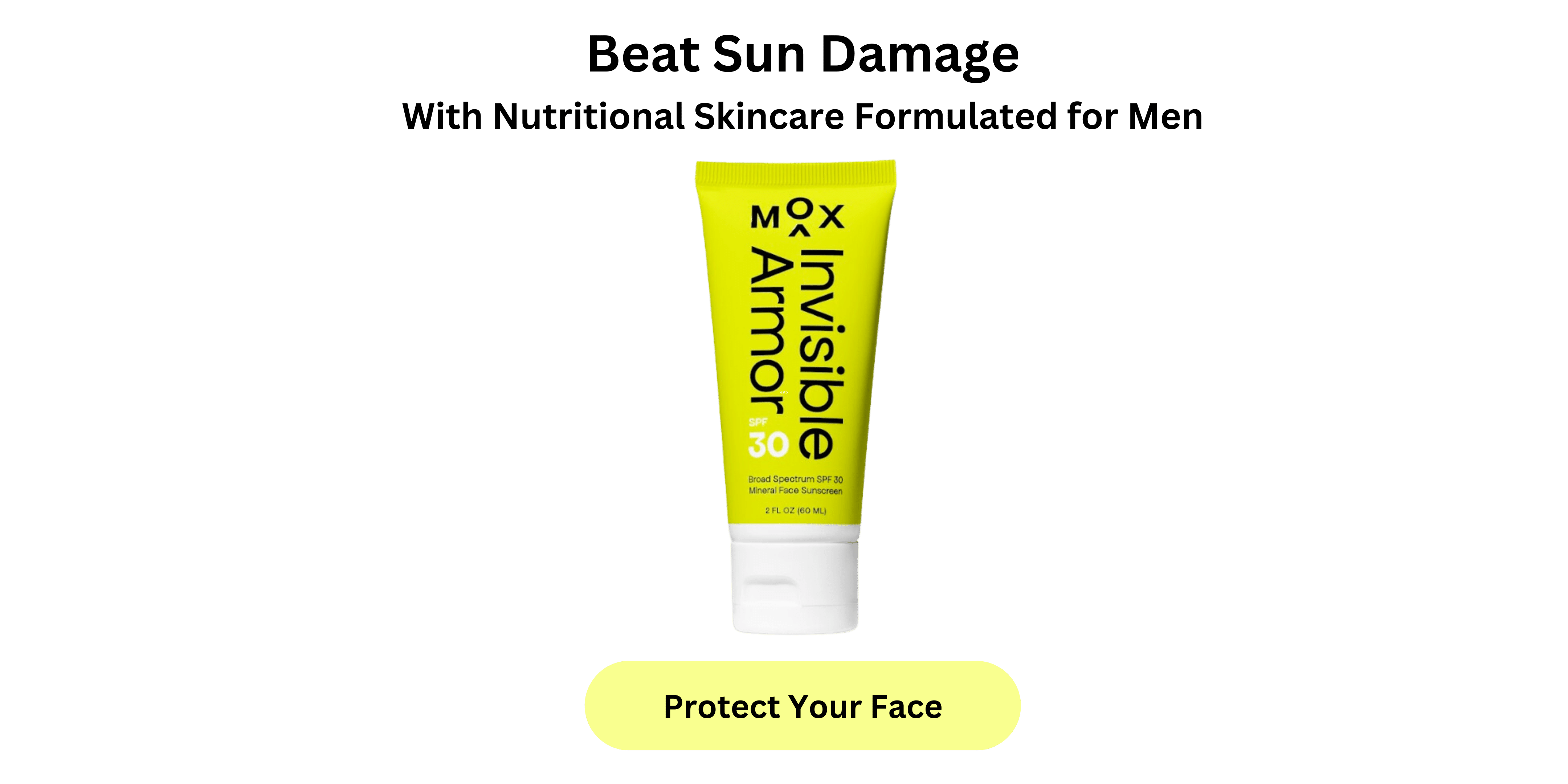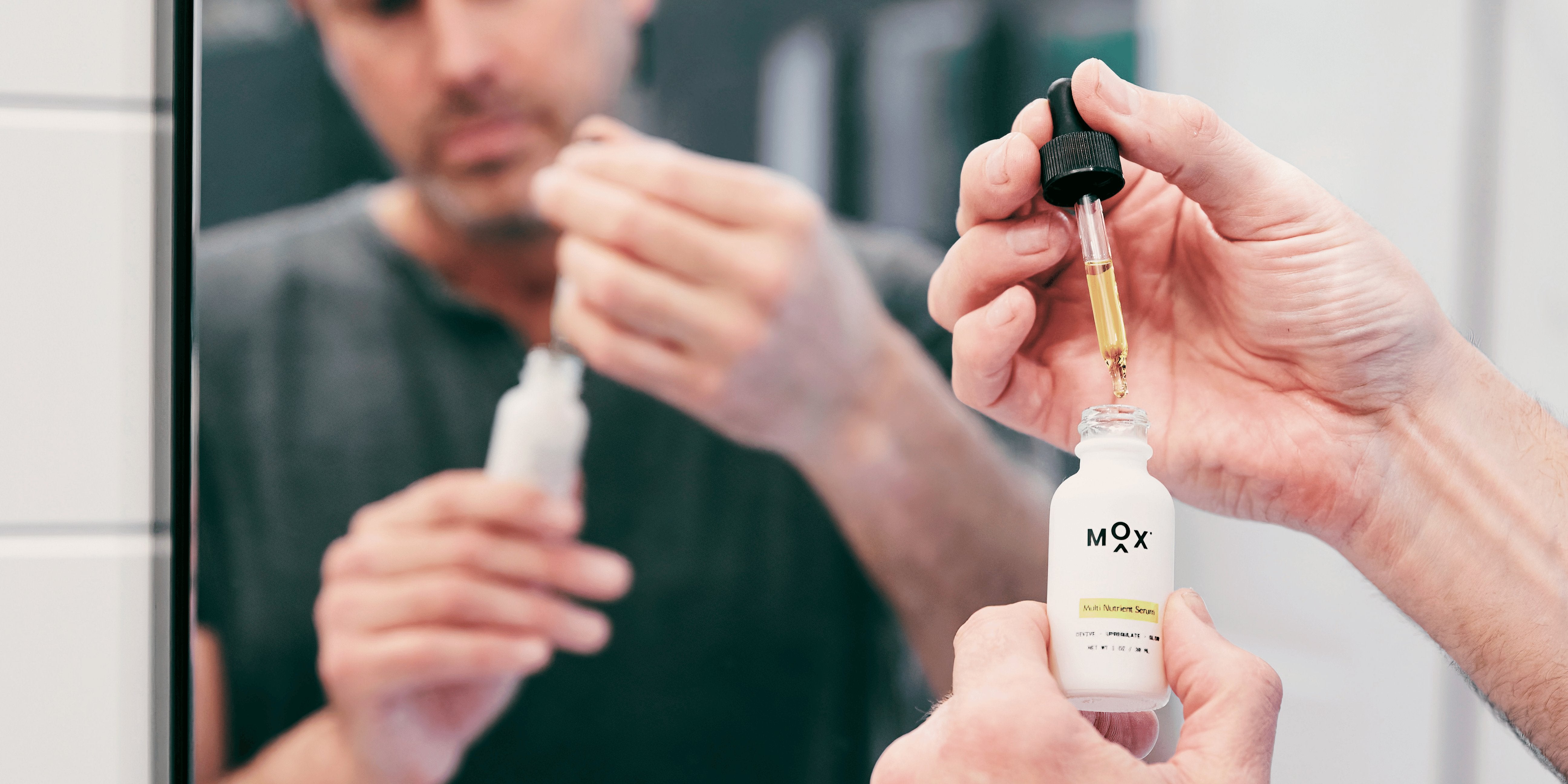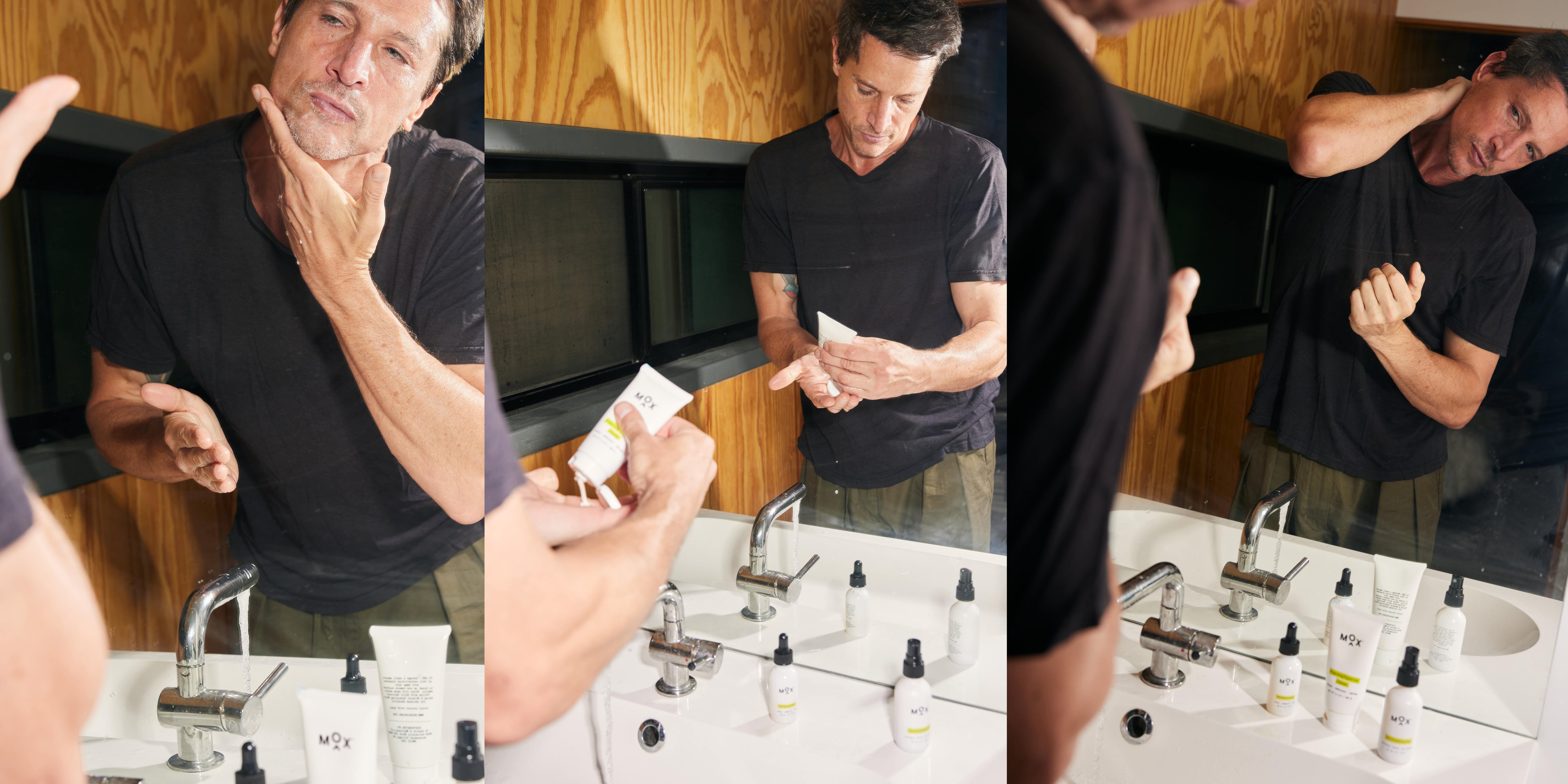When you think of SPF, your mind probably jumps back in time to when lifeguards sported white noses. But – the truth is, guys – SPF is a totally different ballgame in 2023 and recent studies have shown that men are more susceptible to sun damage than women. So while the comical white cast is a thing of the past, it’s vital to crack down and learn about sun damage because sun protection isn't just a choice; it's a statement of health, strength, and responsibility.
But what even is SPF? What do SPF numbers mean? Isn’t it just for swimming or hiking in the direct sunlight? And is men’s skin more susceptible to sun damage? Let’s find out:
What Do SPF Numbers Mean? FACT: Men Are More Prone to Sun Damage Than Women

There’s a perception out there that men’s skin is more delicate than women’s, but – this couldn’t be farther from the truth. In fact, did you know that there are quite a few differences between men's and women’s skin? One is that men’s skin is much more susceptible to sun damage for reasons like skin thickness and collagen levels. Here’s a breakdown:
Men Have Thicker Skin Than Women
Men tend to have thicker skin than women. While thicker skin can provide you with some natural protection, it also contains more sebaceous (oil) glands and larger pores, which means – as a guy – your skin may be oilier and more prone to acne. This increased oiliness can trap UV radiation, causing a lot of potent sun damage.
When we say that men’s skin is thicker than women’s skin, we mean by up to 25%. However, this does vary from person to person. Men’s skin also tends to have a tougher texture. Because of these things, men commonly have fewer fine lines than women (think frown lines and smile lines).
Men Have More Collagen Than Women
Men have more collagen in their skin, which can make it appear young-looking and resistant to wrinkles. Collagen can be looked at as the scaffolding that holds your body together; it’s a protein that can be found in your skin, muscles, tendons, and bones. But collagen can absorb and retain UV radiation, causing sun damage and/or skin cancer.
It’s also important to note that the collagen in men’s skin reduces at a constant rate over the years, while the collagen content in women’s skin reduces later in life, mostly after menopause. Because the thinning is more dramatic over a shorter period, the effects of collagen reduction in female skin are much more obvious.
This basically means that men’s skin ages slower than women’s.
Men Have Less Subcutaneous Fat Than Women
Men generally have less subcutaneous (under-the-skin) fat than women. Subcutaneous fat is like a cushion or padding that helps keep your body warm, protects your organs, and provides shape to your body. When you pinch your skin, and there's some softness there, that's the subcutaneous fat you're feeling, which is pretty interesting if you ask us!
The reason why women don’t have as much subcutaneous fat as men is that they may become pregnant, so their bodies stock energy in the form of fat in anticipation. Since men have less subcutaneous fat than women, they don’t have as much natural insulation against UV radiation, increasing men’s risk of skin damage and cancer.

What Do SPF Numbers Mean? Do Men Need Broad-Spectrum SPF Every Day?
 Pictured: What Do SPF Numbers Mean? | Source: MOX
Pictured: What Do SPF Numbers Mean? | Source: MOX
SPF stands for "Sun Protection Factor;” it's like a shielding armor for your skin. The number of SPF tells you how good the formulation is at protecting your skin from getting damaged or sunburned. The higher the number, the stronger the protection. This basically means that if you see SPF 30 written on a label, you can stay in the sun 30 times longer than without sunscreen.
As they say – the proof is in the pudding: All it takes is one sunburn as a child to more than double your chances of developing melanoma – skin cancer – in your lifetime. And since we live in a world where your skin speaks volumes and first impressions matter, here’s another stat: It’s been found that sun exposure is the cause of 80-90% of all visible signs of skin aging.

Pictured: Former truck driver of 28 years who always had his left side towards the window; notice the difference in skin texture and appearance between the more sun-damaged side (right) and the other that was still exposed but not as directly or as often (left) | Source: CBS News
SPF products should always be “broad-spectrum,” which means that it protects you from both UVA and UVB rays. Here’s an easy way to distinguish between the two: UVA(ging) and UVB(urning). While both UVA and UVB rays have similar effects, UVA rays are mostly connected with fine lines and dark spots, while UVB rays play a role in burns and skin cancer.
What Do SPF Numbers Mean? What Is Skin Cancer? What’s It Look Like?
Skin cancer happens when the cells in your skin start to grow abnormally. While it’s normal for skin cells to grow and divide in an orderly way to replace old or damaged ones, sometimes things go wrong – like after exposure to the sun’s rays – and you’re left with skin cancer.
There are three main types of skin cancer to keep in mind:
- Basal Cell Carcinoma (BCC): This is the most common type of skin cancer; it appears as a small, shiny bump or a pinkish patch of skin and can be found where you get a lot of sun. Nearly 4.3 million cases of BCC are diagnosed in the U.S. each year.
- Squamous Cell Carcinoma (SCC): This type is also common and often looks like a scaly, red bump or a sore that won't heal. It can sometimes spread to other parts of your body if not treated. Around 1 million cases of SCC are diagnosed annually in the U.S.
- Melanoma: This is the most serious type of skin cancer and often looks like an unusual mole. It can grow quickly and spread to other parts of your body with early detection and treatment being crucial. It’s estimated that there are 60,460 new cases of melanoma in men each year and about 39,280 new cases in women.

When looking for skin cancer on your body, try thinking of the ABCDE rule to tell you what signs to watch out for:
- Asymmetry: Irregular shape
- Border: Blurry or irregularly shaped edges
- Color: Mole with more than one color
- Diameter: Larger than a pencil eraser (6 millimeters)
- Evolution: Enlarging, changing in shape, color or size
Remember: Skin cancer is preventable and treatable if you catch it early. Protecting your skin from the sun and being aware of changes on your skin are essential steps in staying healthy.
Photos of Skin Cancer: Normal vs. Cancer Cell
 Pictured: Normal vs. Cancer Cell | Source: Khan Academy
Pictured: Normal vs. Cancer Cell | Source: Khan Academy
 Pictured: Basal Cell Carcinoma (BCC) | Source: First Derm
Pictured: Basal Cell Carcinoma (BCC) | Source: First Derm
 Pictured: Squamous Cell Carcinoma (SCC) | Source: American Skin Association
Pictured: Squamous Cell Carcinoma (SCC) | Source: American Skin Association
 Pictured: Melanoma | Source: AOCD
Pictured: Melanoma | Source: AOCD
What Do SPF Numbers Mean? More Things To Know About Skin Cancer
 While we previously touched on some eye-opening stats, the truth of the matter is that men are more likely to experience skin cancer that’s dangerous and potentially fatal. While being able to answer questions like, “What do SPF numbers mean?” and “Do you need broad-spectrum?” are vital, it’s also important to familiarize yourself with skin cancer so you know what to look out for.
While we previously touched on some eye-opening stats, the truth of the matter is that men are more likely to experience skin cancer that’s dangerous and potentially fatal. While being able to answer questions like, “What do SPF numbers mean?” and “Do you need broad-spectrum?” are vital, it’s also important to familiarize yourself with skin cancer so you know what to look out for.
Here are some more things men need to know about skin cancer:
- It’s Serious, Seriously: A common misconception among guys is that – if you develop skin cancer – it just takes some visits to your doc and a simple procedure or two to remove it. While this is true for some forms of skin cancer, melanoma, specifically, can be spread to other parts of your body and is very difficult to treat as it can be fatal.
- Looking At Your Skin Regularly Matters: You’re probably like, “C’mon, I look at my skin every day,” but we mean really look at your skin. Taking a shower after a sweaty, electrolyte-diminishing gym sesh is the perfect time to do this. Look for moles, bumps, or spots that are growing, irregularly shaped, multicolored, or prone to bleeding. If you see any changes in moles you’ve had your entire life, let your doc have a look to be safe.
- Protective Clothing Works: When you mow the grass or head out on a hike, you probably sport a baseball cap, which can protect your scalp (AKA where many skin cancers develop). However, many experts recommend wide-brim hats to shade not only your scalp but your ears and neck, too. Additionally, if the weather allows it and you have breathable options, try long-sleeve shirts and pants for added sun protection.
- SPF Is Your New BFF; No If, Ands, or Buts About It: Men don’t commonly wear SPF daily; that’s just how it is, but it doesn’t have to be. In the grand scheme of things, men tend to use less SPF than women because they don’t like the texture or look of it, they’re not up to speed on skin cancer, self-care isn’t their forte, or maybe they just don’t know what to buy. That’s where MOX comes in:
What Do SPF Numbers Mean? Now That You Know, Grab the MOX SPF 30 Mineral Sunscreen
The idea behind the MOX SPF 30 Invisible Armor Mineral Sunscreen comes from Bob Reifsnider, a co-founder, whose experience with sun damage caused him to dial in on his lack of skin protection in his youth. Here’s what he had to say:
“As you get older, you try to impart some knowledge to the younger generation that going out without sunscreen or trying a tanning bed isn’t cool. Skin cancer and sun damage are real things, and I don’t know if that set in for me before being told I had skin cancer.”
“The MOX Mineral Sunscreen is a mineral defense mechanism that also absorbs into your skin for not only sun protection but other benefits, too. I don’t want to be dramatic, but SPF is an important topic; it can end up being life-threatening if it’s not taken seriously and used daily.”
The reason why we decided to make the MOX Sunscreen a mineral SPF is because of this tidbit of info: Minerals sit on the top of skin, acting similar to a mirror by reflecting UV rays away from your body. The ingredients in chemical SPFs actually absorb into your skin, potentially migrating into your bloodstream.

Before you head off, grab the MOX SPF 30 Invisible Armor Mineral Sunscreen and sign up for our email list to stay updated on new product launches. Don’t forget – (for those of you who were asking: What do SPF numbers mean?) skin cancer is preventable, so make applying SPF a norm.





Leave a comment
This site is protected by hCaptcha and the hCaptcha Privacy Policy and Terms of Service apply.